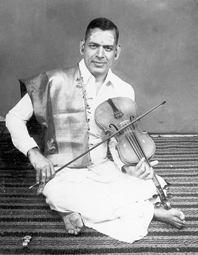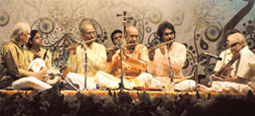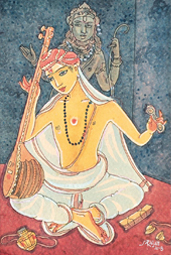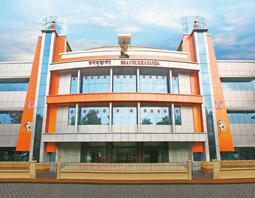COVER STORY - M.S. Gopalakrishnan (1931 - 2013) by N. RAMANATHAN

M.S. Gopalakrishnan symbolised the development of a new violin technique, a variation in the idiom of Carnatic music and thorough commitment and professionalism in music.
Gopalakrishnan cannot be understood in isolation; that, of course, applies to any musician. He has to be viewed in the background of the musicians – violinists in particular – who belonged to the previous generation, and fellow violinists. The principal violinists of the previous generation would be Kumbakonam Rajamanickam Pillai, T. Chowdiah and Dwaram Venkataswamy Naidu. Their violin playing reflected the singing and melodic texture of that era. It was a combination of rounded plain swaras, and swaras incorporating limited oscillation or kampita. The plain swaras were expressed through individual finger touches, known as viraladi. The phrases involving swaras with an image of up and down sliding movement, used plain fingers, juxtaposed with a finger sliding normally executed by the index finger. The range of the sliding was limited. Naidu displayed a number of movements reflecting oscillations and sliding; his viraladi attained such great sophistication that it concealed the discrete swaras and bestowed a continuity through the dextrous way in which one finger took over the melody from the other and through the alternation of intensity (vallinam - mellinam). His aim was also to preserve and retain the basic timbre and tonal quality of the violin that had been imbibed from Western music. In fact such sophistication in technique had already been visible a few decades earlier in the veena playing of Dhanammal, which differed from that of her contemporaries like Mysore Seshanna.
SEASON - New season, old content by M.V. SWAROOP

It is hard to offer fresh perspective on the Chennai December season, for each season is, in so many ways, like the other. The sabhas’ schedules are pretty much fixed. Sometimes, the same artist plays on the same date each year. The venues are the same, time slots are the same, their duration is fairly standard. The musicians are, by and large, the same, their styles are well known, the audience is made up of an army of friends, acquaintances and vaguely familiar faces. The corpus of ragas and kritis offered is approximately the same. The sponsors are, almost everywhere, the three or four cloth shops from around T. Nagar, and the odd hospital conglomerate. Even the canteens are run by the same caterers offering very similar menus each year.
It gets bigger each year, yes. Organisations mushroom all over the city, offering music, dance and drama for fifteen to twenty days, only to vanish after the festival. The season guide booklets have now become veritable pillows of schedules.
It gets madder each year, perhaps. Some rasikas enter into boasting matches on how many concerts they have attended. One, who came to the city just for the season, and even took a house on rent for the month, told me that he attended seven concerts on a single day. I wonder how many of those he listened to. Some artists accept up to 40 concerts in the space of a month. Sometimes the artist himself gives the concert a mental miss, choosing to go through it as if it were a poetry recital in his fifth standard classroom.
REMEMBERING - A devotee of Tyagaraja by WILLIAM J. JACKSON

I remember my uncertainties in the darkness after many cramped hours in flight on the plane to Madras in September 1980. I had been to India for several months in 1970, and again briefly in 1977, but this time I had a specific academic task and a long-range goal – to conduct research for my Harvard University Ph.D. thesis. The topic was to be the life and works of Tyagaraja, the great singer-saint who composed hundreds of memorable songs, raising Carnatic music to new heights of artistic achievement and devotional power.
Would I meet the right guides? Would they look kindly upon me and agree to give me the help I would require to enter into the culture? Did I have enough language training to be accepted and get started in this very tradition-conscious region of the earth? I felt at the mercy of a different social world and had no idea how my first large-scale research project would turn out. So far from home with only new acquaintances to call on, I tried to stop worrying and to hope for the best.
INSTITUTION - Diamond jubilee celebrations at Mumbai by GAYATHRI SUNDARESAN

2012-2013 is a year of celebration for the Shanmukhananda Fine Arts & Sangeetha Sabha in Mumbai. The diamond jubilee of the sabha coincides with the golden jubilee of its famous Sri Shanmukhananda Chandrasekharendra Saraswati Auditorium. Over six decades Shanmukhananda has grown from a cultural sabha into a self-sustainable cultural institution with multifarious activities. Though Shanmukhananda Sabha was established in Bombay in 1952 with the aim of promoting fine arts in the city, today its objectives have expanded to provide a platform to up-and-coming talent, impart proper training in fine arts to aspiring students, provide affordable health care in certain critical areas to the vulnerable sections of society, and to promote national integration through its various activities.
Over the years, the auditorium has been the venue for programmes ranging from concerts of music and dance, to school functions, political and business conventions, to august performances by national and international orchestras. The auditorium, with a seating capacity of over 2700, has been and continues to be the venue for some of the finest cultural events and programmes in the field of performing arts in Mumbai.


